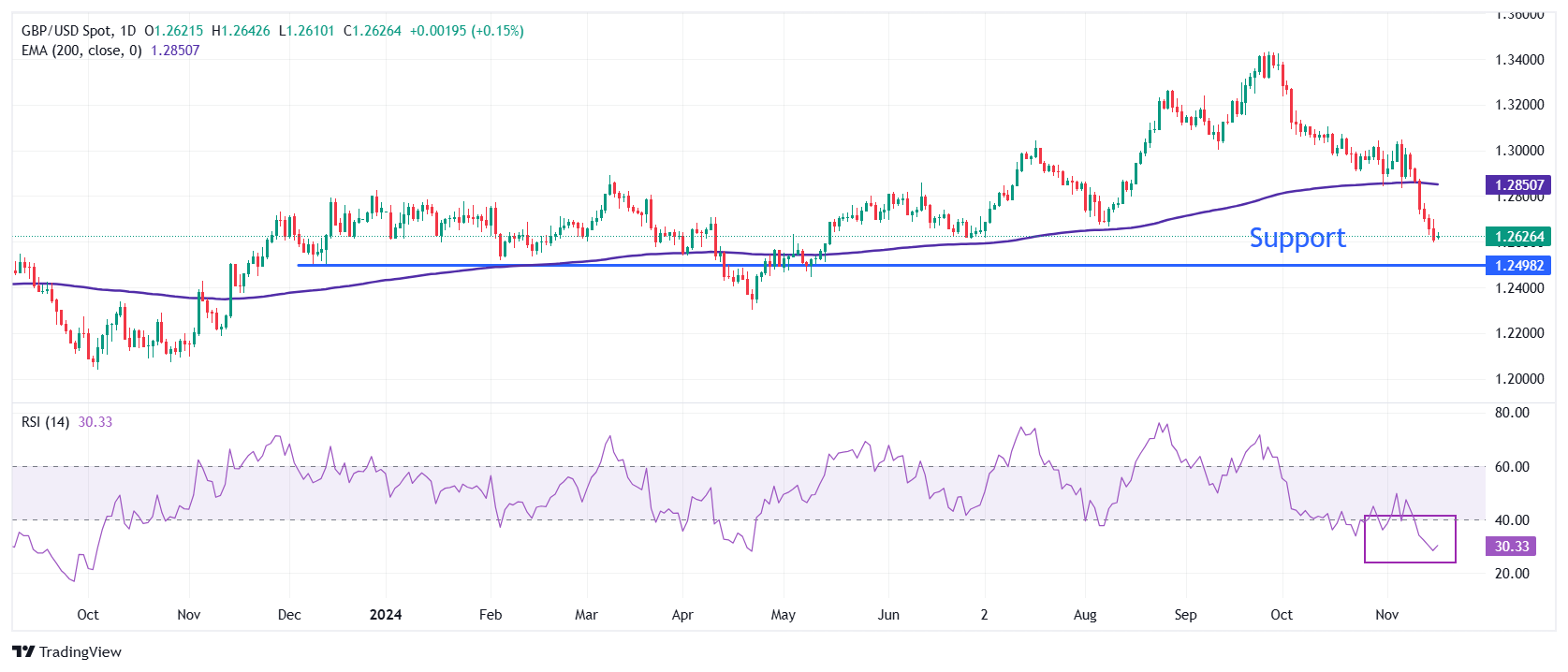Pound Sterling faces pressure against USD as Fed dovish bets ease

- The Pound Sterling rebounds slightly after weak UK GDP-driven-selling on Friday.
- The next big move for the British currency will likely occur on Wednesday when UK inflation data for October will be released.
- Fed officials refrain from projecting the consequences of Trump’s policies on interest rates.
The Pound Sterling (GBP) remains under pressure near 1.2600 against the US Dollar (USD) in Monday’s North American session. The GBP/USD pair struggles to gain ground as the US Dollar clings to gains near a more-than-a-year high, with the US Dollar Index (DXY) wobbling around 107.00.
The Greenback trades firmly as investors expect the Federal Reserve (Fed) to follow a more gradual rate-cut approach given the recent slight rebound in inflation and the growth outlook on strong expectations that President-elected Donald Trump will be able to implement his economic agenda smoothly.
In the December meeting, there is a 62% chance that the Fed will cut interest rates by 25 basis points (bps) to 4.25%-4.50%, according to the CME FedWatch tool. This is significantly down from the almost 77% seen a month ago.
Trump’s victory is also making analysts reassess the Fed’s interest-rate outlook for next year. “The Fed’s Monetary Policy Committee (MPC) will be acutely aware that Donald Trump’s policies could be significantly inflationary, primarily due to the impact of tariffs being passed on to consumers while lower taxes heat up the economy,” analysts at Quilter Investors said. “Investors will no doubt be combing through their comments carefully for any perceived guidance on how that might impact the path of interest rates going forward,” they added.
Meanwhile, Fed officials have refused to comment on the likely impact of Trump’s policies on the monetary policy action and the economic outlook. On Thursday, Fed Chair Jerome Powell said that “it is too early to reach judgments on the effect of Trump policies.”
On the economic data front, investors await the preliminary S&P Global Purchasing Managers’ Index (PMI) data for November, which will be published on Friday.
Daily digest market movers: Pound Sterling remains on backfoot against US Dollar
- The Pound Sterling edges higher against its major peers on Monday, striving to gain ground after Friday’s sell-off. The British currency fell sharply after the United Kingdom (UK) Office for National Statistics (ONS) showed that the economy surprisingly contracted by 0.1% in September. The data also showed that the economy barely grew in the third quarter.
- The unexpected fall in UK GDP could prompt expectations for more interest rate cuts by the Bank of England (BoE). “We believe that if UK economic data continues to disappoint, the BoE may become more focused on reviving growth,” according to analysts at BBVA.
- The uncertainty over the UK economic outlook is expected to deepen further as the government is caught between choosing the European Union (EU) and the US for strengthening its trade relations. The comments from Stephen Moore, a senior economist advisor to Donald Trump, in an interview with BBC indicated that the US will be less interested in working with the UK if it puts the EU ahead of it.
- “The UK is kind of caught in the middle of these two forms of economic model and I believe that Britain would be better off moving towards more of the American model of economic freedom. And if that were the case, I think it would spur the Trump administration’s willingness to do the free trade agreement with the UK,” Moore said. His comments came after BoE Governor Andrew Bailey urged the administration to rebuild ties with the European Union.
- This week, investors will pay close attention to the UK Consumer Price Index (CPI) data for October, which will be published on Wednesday. The inflation data is likely to influence BoE rate cut expectations for the December meeting.
Technical Analysis: Pound Sterling wobbles near 1.2600
The Pound Sterling aims for a firm footing near 1.2600 against the US Dollar in European trading hours on Monday. The GBP/USD pair remains broadly under pressure as it remains well below the 200-day Exponential Moving Average (EMA) at 1.2850.
The 14-day Relative Strength Index (RSI) slides sharply to 30.00, suggesting a strong bearish momentum.
Looking down, the psychological support of 1.2500 will be a major cushion for Pound Sterling bulls. On the upside, the Cable will face resistance near the 200-day EMA.
